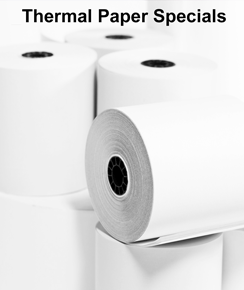What is Thermal Paper and How to Use it?
Thermal paper is a type of paper that changes color when heated by the thermal printer head. Unlike typical ink-jet printers, which use an electrically powered print head to eject ink that then permanently dyes the paper, papers with thermal properties (thermal transfer) produce images by selectively heating portions of it.
Because thermal paper is not ink-based, it is less prone to smudging and fading, and also has higher durability than paper with dyes. The chief difference between thermal and ink-jet printers is that the former produces clearer images that last longer than the latter. With ink-jet printers, the print head often leaves streaks on the surface of the paper.
Thermal papers or thermal printer paper come in rolls and hence do not require any tray to be installed. They are easy to install, use, maintain and clean as compared to their counterparts in inkjet printing which are available in cartridges. As they produce less waste, they contribute to reducing the carbon footprint as well.
Thermal paper is most commonly used for printing receipts, invoices, packing lists, and delivery documents. Thermal paper receipts have in fact, become immensely popular and account for a huge chunk of receipts that are produced.
How does Thermal Paper Work?
Thermal paper contains heat-sensitive dyes and pigments which are activated on the application of heat. The ways dyes are applied to thermal papers varies from manufacturer to manufacturer. However, thermal papers usually share a host of other similarities.
In order to print an image, the thermal paper must be heated. The printer head emits heat by means of a heated bimetallic strip which is connected to the thermal head. The heat causes the colorants in the thermal paper to change their absorption and reflectance effects and they consequently turn dark as they cool down again. This causes a perceptible change in hue.
The printer head also produces an electrical signal to indicate that it has had sufficient time to cool down (called "passing" time). If this signal is ignored, then either there is no ink (the paper hasn't been heated) or the ink color has not yet dared fully develop (the heating process was too short, in practice about one second) or both.
The Uses and Advantages of Thermal Paper Rolls
Now that you understand how thermal paper works, it is important to understand the main uses and advantages that come with the usage of thermal paper rolls. Thermal papers are usually sold in the form of thermal paper rolls.
-
Accuracy
Businesses tend to print thousands and thousands of receipt papers, shipping labels etc for customers every day which makes it important to have an eligible and accurate print. Thermal papers are coated with a smooth layer on top which makes the end result high definition. Since no ink is used, there are no smudges to interfere with the quality.
-
Speed
Thermal papers tend to produce images much quicker than regular paper which makes it more convenient when you have customers lined up.
-
Low Maintenance
One of the biggest advantages of using thermal paper is that it requires little or no maintenance which results in significant cost reduction. The inkless thermal paper uses very less parts too, making it unlikely to jam, especially compared to other printers.
-
Durable
Thermal printers are more durable which make them more cost efficient and convenient to use. Thermal papers are also durable but their durability varies with the thickness of the paper.
Thermal Paper Structure
The thermal paper consists of a structure with multiple layers. Below, you can find details about the most basic structure of thermal papers. Further coatings can be added as per requirements.
- The Base Layer
The base layer of the paper is especially designed for thermal printing technology.
- Precoat Layer
After the base layer comes the precoat layer which is responsible for improving heat insulation, smoothness, uniformity, and anchoring of the thermal layer.
- Thermal Layer
This is the topmost layer and is responsible for producing the images we see, since it contains heat-sensitive pigments and chemicals.
What are the different types of thermal paper?
While now you understand how thermal papers work, before you can go on your hunt for the perfect thermal paper, it is imperative to understand what the different types of thermal papers are.
There are three main factors that differentiate thermal papers: heat, moisture and thickness. When choosing a thermal paper that works just right for your business, you will have to have an understanding of these three conditions.
-
Heat
The majority of the thermal papers can be damaged if temperatures exceed 140 degrees. If you plan on stocking your thermal paper in any place that is likely to reach high temperatures, you will have to purchase thermal paper with coatings that are able to withstand high temperatures.
-
Moisture
Thermal papers are also vulnerable to moisture and it can impact its performance. Moisture can impact the ability to see pictures on thermal paper.
Again, it is pertinent to choose a thermal paper with a coating that is resistant to moisture if you plan on working in an environment with high moisture levels.
-
Thickness
Thermal paper usually comes in the form of thermal paper rolls and is measured in mils. Each mil is calculated as 1/1000th of an inch. The advantage of thicker paper is that the thicker the stock of thermal paper, the more durable it will be.
On the flip side, the thicker paper would mean less quantity of thermal paper in each roll. But that can be easily solved by getting more rolls of paper, so there is no compromise on durability.



